You searched for: %ED%86%A0%ED%86%A0%20%ED%95%98%EB%8A%94%EB%B2%95%20AAA3.TOP%20%EB%A9%94%EC%9D%B4%EC%A0%80%EC%82%AC%EC%9D%B4%ED%8A%B8%20%EC%9C%A0%EB%8B%88%EB%B2%B3%20PIKU%20%EC%9B%94%EB%93%9C%EC%BB%B5%20PIKU%20%EC%9B%94%EB%93%9C%EC%BB%B5%20ioq
<< Previous | Displaying results 376-400 of 497 for "%ED%86%A0%ED%86%A0%20%ED%95%98%EB%8A%94%EB%B2%95%20AAA3.TOP%20%EB%A9%94%EC%9D%B4%EC%A0%80%EC%82%AC%EC%9D%B4%ED%8A%B8%20%EC%9C%A0%EB%8B%88%EB%B2%B3%20PIKU%20%EC%9B%94%EB%93%9C%EC%BB%B5%20PIKU%20%EC%9B%94%EB%93%9C%EC%BB%B5%20ioq" | Next >>
-
Beifeld album page illustrating military events
Artifact(Top) A map dated August 1942 showing the area of the late summer skirmishes between Hungarian and Soviet forces. It also shows the crucial bend in the Don River near the town of Uryv, where the fateful Soviet breakthrough occurred in January 1943. (Bottom) "Fairy tale nights along the Don River, August 1942." [Photograph #58058]

-
Beifeld album page with watercolors titled "Sports weeks" and "Quiet Don"
Artifact(top) "Watercolor entitled 'Sports weeks in Uryv, September 1942' in which a Russian tank attacks a Hungarian unit in Uryv."; (bottom) "Watercolor entitled 'Quiet Don: a detailed map of the Don River area' featuring images of dead soldiers, horses and spilled blood on a map of the Don River." [Photograph #58060]
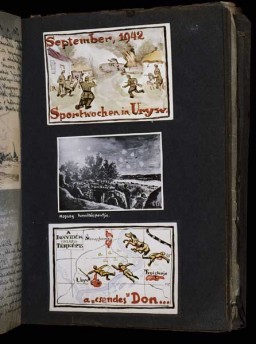
-
Samuel Soltz's visa
DocumentThe back of Samuel Soltz's citizenship papers illustrates the vast array of bureaucratic stamps and visas needed to emigrate from Europe in 1940–41. The stamp in the top left, dated August 21, 1940, represents a visa from the Japanese consul to Lithuania, Chiune Sugihara. Sugihara issued thousands of visas to enable Jews to escape.
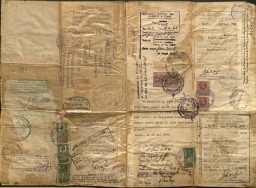
-
Renovating the courtroom to be used for the International Military Tribunal
PhotoRepairs and improvements are made to the courtroom where the International Military Tribunal trial of war criminals would be held. The holes in the walls at the top (when completed) housed radio commentators and public address operators. September 11, 1945.
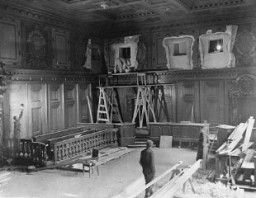
-
Display from "Der ewige Jude," a Nazi antisemitic exhibit
PhotoDisplay from "Der ewige Jude" (The Eternal Jew), a Nazi antisemitic exhibit which claimed that Jews heavily dominated the German performing arts. A phrase at the top of the display states "Shameless Entertainment." Berlin, Germany, November 11, 1938.
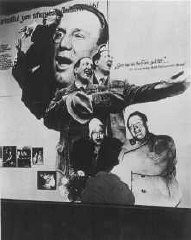
-
Portrait of a preschool class in Copenhagen, Denmark
PhotoPortrait of a preschool class in Copenhagen. Gus Goldenburger (top row, second from left) was one of the few Jewish students in the class. His family moved to Denmark from Czechoslovakia, fearing the rising tide of Nazism. When the Nazis planned to deport Danish Jewry, the Goldenburgers managed to escape to Sweden, where they remained until the end of the war. After the war, the Goldenburgers returned to Copenhagen. Photograph taken in Copenhagen, Denmark, 1938–1939.
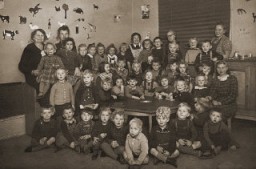
-
Portrait of a boarding school class in which a Jewish boy was hidden
PhotoClass photograph of students at the San Leone Magno Fratelli Maristi boarding school in Rome. Pictured in the top row at the far right is Zigmund Krauthamer, a Jewish child who was being hidden at the school. Rome, Italy, 1943–44.

-
Portrait of Norman Salsitz's family
PhotoIn this 1934 portrait of Norman Salsitz's family, Norman is seated in the front row (at left). In the top row, center, an image of one of Norman's brothers has been pasted into the photograph. This is seen by comparing the size of the brother's face with the others pictured. Pasting in images of family members who could not be present during family portraits was common practice and in some cases the resulting composite images are the only remaining visual records of family groups.

-
Werner Hegemann
ArticleWerner Hegemann was a city planner and author. The Nazis opposed his views of American architecture and German historical figures. His book was burned in 1933.
-
Gartenberg family portrait
PhotoFamily portrait of the Gartenberg family in Drohobycz, Poland. None of those pictured would survive the Holocaust. Photograph taken in 1930. Top row: Julius Gartenberg, Anna Fern, Bernard Klinger, Ona Fern and Izador Gartenberg. Lower row: Marcus Gartenberg, Hinda Gartenberg with her grandaughter Tony Schwartz on her lap, Sol Schwartz, and Ida Fern.

-
Poster for Nazi Party speech on Jewish Bolshevik threat
PhotoPoster for a meeting and speech about the Jewish Bolshevik threat against Germany sponsored by the local Nazi Party of East Hannover. Depicted is a silhouetted caricature of a Jewish man’s head in left profile, with a large, red Star of David beside him. The announcement at the top of the poster reads: "Victory over Bolshevism and plutocracy means being freed from the Jewish parasite!" Created ca. 1937–1940.
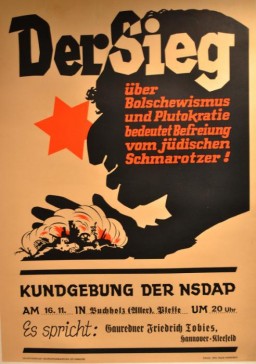
-
Warsaw Ghetto Sealed
Timeline EventNovember 15, 1940. On this date, German authorities ordered the Warsaw ghetto to be sealed.
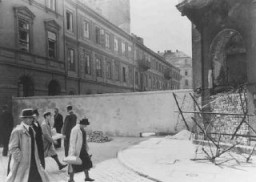
-
Buchenwald
ArticleThe Nazi regime established the Buchenwald camp in 1937. Learn about the camp’s prisoners, conditions there, forced labor, subcamps, medical experiments, and liberation.

-
Beifeld album page about events of August 28, 1942
Artifact(Top) A drawing dated October 1942 depicting the events of August 28 when Beifeld was wounded near the front lines. His caption reads: "I get wounded and manage to get away from the dangerous bend in the [Don] river]." (Bottom left) Skull of a Soviet soldier with the caption 'Keep Smiling.' (Bottom right) Map entitled 'Dangerous Curve' depicting the bend in the Don River where the Soviet army was threatening to break through. [Photograph # 58061]

-
Eugenio Gentili Tedeschi
ArticleRead the Jewish Partisan Educational Foundation's short biography of Eugenio Gentili Tedeschi.
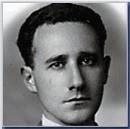
-
Samuel Soltz's Visa
Timeline EventAugust 21, 1940. On this date, Samuel Soltz's visa was stamped by Chiune Sugihara, the Japanese consul to Lithuania.

-
Abraham Bomba describes the Treblinka gas chambers
Oral HistoryExcerpt from Holocaust survivor Abraham Bomba's oral history testimony describing gas chambers at the Treblinka killing center.
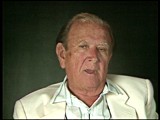
-
Chelmno
ArticleThe Chelmno killing center was the first stationary facility where poison gas was used for mass murder of Jews. Killing operations began there in December 1941.

-
Maria Nemeth
ID CardMaria's parents lived in Szentes, a town in southeastern Hungary, located 30 miles from the city of Szeged. Her mother, Barbara, was born in the neighboring town of Hodmezovasarhely, but moved to Szentes when she married. Maria's father was a dentist. 1933-39: Maria was born in 1932. In 1937 her mother took in a young Austrian woman who lived with the family and helped Maria learn German. 1940-44: In March 1944 German troops occupied Hungary. Members of the Hungarian fascist party, Arrow Cross,…

-
Nazi Rule
ArticleAfter they rose to power in 1933, Hitler and the Nazis eliminated democratic freedoms and took control of all aspects of public life in Germany. Learn more.

-
The Malmedy Massacre
ArticleOn December 17, 1944, one day after the beginning of the Battle of the Bulge, a Waffen SS unit captured and murdered 84 US soldiers. This atrocity is known as the “Malmedy Massacre.”

-
Hitler Youth
ArticleThe Hitler Youth and the League of German Girls were developed as Nazi Party youth groups to indoctrinate children and youth in Nazi ideology and policy.

-
Léon Degrelle
ArticleLéon Degrelle was an extreme right-wing Belgian politician and Nazi collaborator. After the war, he continued to spread pro-Nazi propaganda for decades. Learn more.
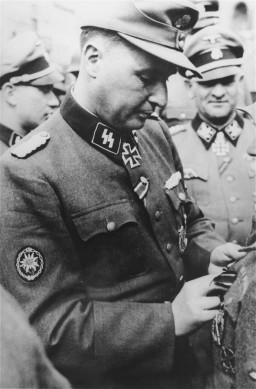
-
David (Dudi) Bergman describes liberation by US Army in mountains near Innsbruck
Oral HistoryThe Germans occupied David's town, previously annexed by Hungary, in 1944. David was deported to Auschwitz and, with his father, transported to Plaszow. David was sent to the Gross-Rosen camp and to Reichenbach. He was then among three of 150 in a cattle car who survived transportation to Dachau. He was liberated after a death march from Innsbruck toward the front line of combat between US and German troops.
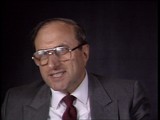
-
Selma Engel diary entry about life in hiding
ArtifactDiaries reveal some of the most intimate, heart-wrenching accounts of the Holocaust. They record in real time the feelings of loss, fear, and, sometimes, hope of those facing extraordinary peril. Selma Wijnberg and Chaim Engel met and fell in love in the Sobibor killing center. After the young couple made a daring escape during the camp uprising and fled into hiding, Selma began a diary to record their experiences. The diary was written in 1943-1944 while Selma was in hiding in German-occupied…

